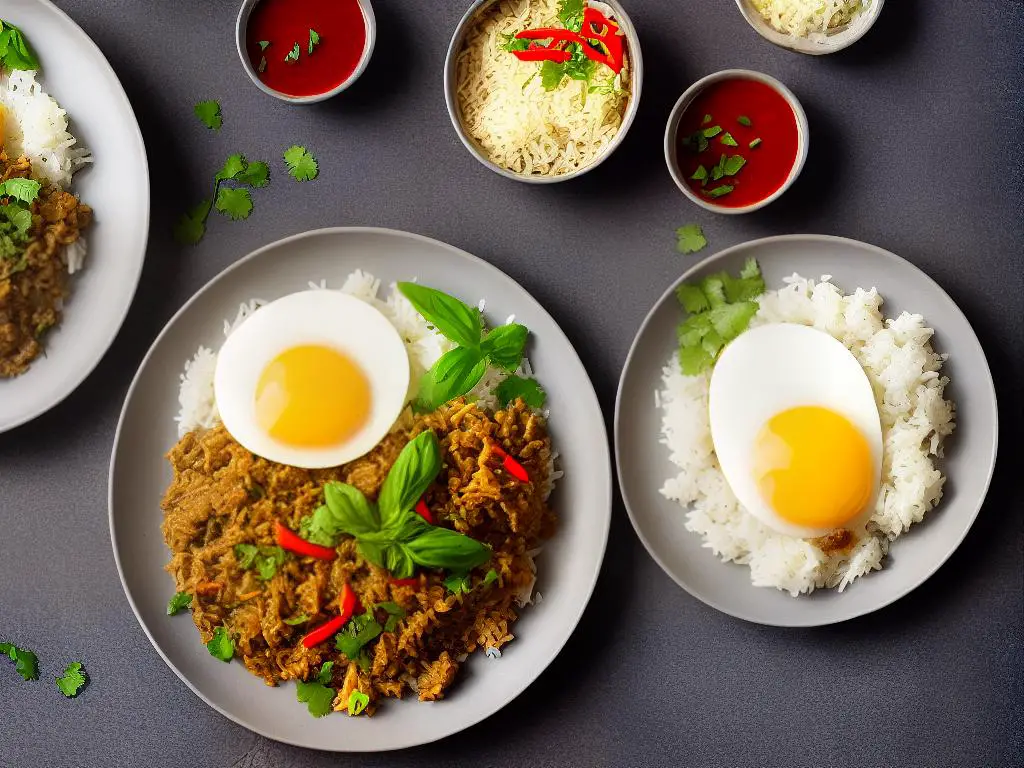Derived from Thai culinary heritage and fast becoming a contemporary delight, Kaprao Pork Rice exemplifies the essence of flavourful street food that caters to global tastes. This essay delves into the journey of Kaprao Pork Rice’s transformation from a humble yet popular Thai street food to a star attraction on McDonald’s Thailand menu. The fascinating evolution of this dish is not just a reflection of its rich history and origins, but also represents the growing appetite for diverse and authentic food experiences by the masses. Furthermore, this essay assesses the impact of incorporating Kaprao Pork Rice into McDonald’s offerings, showcasing the brand’s innovative approach to embracing diverse culinary traditions and expanding their global reach.
History and Origins of Kaprao Pork Rice
History of Kaprao
Kaprao Pork Rice traces its roots back to traditional Thai cuisine, specifically to the perennially popular dish, Pad Kaprao. This staple food is commonly prepared with stir-fried minced pork, holy basil, garlic, chillies, and fish sauce, served over steamed jasmine rice. The Kaprao Pork Rice often comes with a crispy fried egg on top, adding an extra layer of texture and flavour to the dish. It is believed to have originated in Central Thailand, where the holy basil is predominantly found.
The name “Kaprao” is derived from the Thai word for holy basil, which itself is a key ingredient and lends a distinctive aroma and taste to the dish. The use of holy basil in Thai cuisine dates back centuries, with the herb being an essential component in various dishes due to its unique flavour and purported health benefits.
Growing Popularity and Street Food Culture
Over time, Kaprao Pork Rice has gained immense popularity not only across Thailand but also worldwide. The dish’s ubiquity as a staple food can be attributed to its simple yet flavourful appeal, coupled with the ease of preparation. The ever-growing street food culture in Thailand has also played a significant role in the dish’s increasing prominence among locals and tourists.
While variations of the Kaprao Pork Rice exist throughout Thailand, the dish remains true to its basic flavours and methods of preparation. Its affordability and adaptability have solidified its status as a beloved comfort food item, often sought out by those craving an authentic Thai experience.
McDonald’s Thailand Adoption
McDonald’s Thailand, recognizing the widespread appreciation for Kaprao Pork Rice, introduced their very own version of this classic dish in February 2018. Titled “Rice & Stir-Fried Kaprao Pork with Fried Egg,” the fast-food giant’s take on this popular Thai dish stays fairly true to the original recipe, while incorporating the unique flavour of their own pork patties.
The inclusion of a quintessential Thai dish like Kaprao Pork Rice into McDonald’s menu highlights the company’s dedication to localisation and catering to regional tastes. It also signals their willingness to embrace and contribute to popularising Thai cuisine, further increasing its appeal to fast-food consumers who might not have ventured to try traditional dishes.
Introduction
Kaprao, also spelled as kaphrao or pad krapow, is a popular Thai dish made from stir-fried meat (typically pork, chicken, or seafood) with holy basil, chillies, garlic, and a series of sauces. The dish is usually served over jasmine rice and often accompanied by a fried egg on top. In response to the local palate, McDonald’s Thailand introduced their own version, Kaprao Pork Rice, providing a twist on this traditional Thai favourite.

Taste Test and Comparison
Conclusion
In conclusion, Kaprao Pork Rice has evolved from a simple dish rooted in traditional Thai cuisine to a globally recognised staple food enjoyed by many. The journey of its history and origins demonstrates the adaptability and growth potential of ethnic dishes that can become embedded in global food culture. McDonald’s Thailand’s incorporation of Kaprao Pork Rice into their menu highlights the importance of embracing local tastes and furthering the reach of traditional recipes, ensuring that they continue to be enjoyed by future generations.
Flavor Profiles
Traditional Thai Kaprao Pork is characterized by its spicy, savory, and slightly sweet flavors, created by the combination of holy basil, chilies, garlic, and sauces such as oyster sauce, fish sauce, and soy sauce. The dish has a rich and fragrant aroma from the holy basil, which is one of the key ingredients and lends a distinct anise-like flavor.
McDonald’s Thailand Kaprao Pork Rice attempts to replicate the traditional flavors associated with Kaprao. However, it falls short of the mark when it comes to closely matching the depth and complexity of the original dish. The McDonald’s adaptation is milder in spice to cater to a wider audience, and it tends to be sweeter than its traditional counterpart. The use of holy basil is also less pronounced in McDonald’s version, resulting in a less fragrant and distinctive taste.
Ingredients
A traditional Kaprao Pork dish consists of minced or sliced pork, holy basil, garlic, chilies, oyster sauce, fish sauce, soy sauce, sugar, and oil for stir-frying. The use of fresh and high-quality ingredients is integral to the dish’s overall taste and presentation.
McDonald’s Kaprao Pork Rice, on the other hand, may utilize their signature ground pork, which is consistent with their other menu items but may not have the same texture or quality as freshly prepared minced pork. Moreover, it is likely that McDonald’s uses processed sauces instead of freshly made ones, resulting in distinct differences in taste and quality compared to traditional Kaprao.
Texture and Presentation
Traditional Kaprao Pork is served over steamed jasmine rice, and known for a harmonious blend of textures from succulent and tender meat, slightly crispy and fragrant basil, to the soft rice that soaks up the flavorful sauce. When served with a fried egg, the gooey yolk adds a rich and creamy element that ties the dish together.
McDonald’s Kaprao Pork Rice may not offer the same range of textures as a homemade or restaurant-made traditional Kaprao. The ground pork may be too uniform in texture and the basil may not be as fresh and crispy as with a dish made from scratch. Moreover, while the presentation of McDonald’s Kaprao Pork Rice may be cleaner and more standardized, it may lack the rustic aesthetic and charm of a more authentic Thai Kaprao Pork dish.
Introduction to McDonald’s Thailand Kaprao Pork Rice
McDonald’s Thailand consistently strives to cater to local tastes and preferences. As a result, they have introduced the Kaprao Pork Rice dish to their extensive menu, which is a traditional Thai dish, well-loved by the country’s populace. This dish comprises stir-fried pork, chillies, garlic, and Thai holy basil, served atop steamed jasmine rice. The addition of Kaprao Pork Rice to the menu highlights McDonald’s commitment to appealing to the local market and further expanding their offerings.

Impact on McDonald’s Brand and Menu
Conclusion
Overall, McDonald’s Thailand Kaprao Pork Rice is an attempt to cater to the local taste by offering a fast-food adaptation of a beloved Thai dish. While it might not match the original in terms of flavour complexity, use of high-quality fresh ingredients, or presentation, it does provide a convenient and affordable option for those seeking a taste of Kaprao on the go. However, for a true and authentic Thai Kaprao experience, one might be better off seeking out a local street food vendor or restaurant that specialises in traditional Thai cuisine.
Impact on the McDonald’s Brand Identity
The addition of Kaprao Pork Rice to the menu of McDonald’s Thailand helps to cement the brand’s reputation as a global fast-food chain that is adaptable and sensitive to the local food culture. By introducing a local dish, McDonald’s demonstrates its understanding of Thai culinary preferences and culture, effectively positioning itself as a brand that caters to local needs rather than imposing American fast-food values.
This further enhances McDonald’s brand identity as a global and local food chain, known for its innovation, ability to adapt, and commitment to the local culinary scene. It also serves to mitigate the image of McDonald’s as a purely American fast-food giant, by embracing the diversity, culture, and flavors of its various markets around the world.
Strengthening McDonald’s Global Presence
By incorporating traditional Thai dishes like the Kaprao Pork Rice into their Thailand menu, McDonald’s solidifies its position as a global fast-food chain with deep connections to the communities and cultures it serves. This shows McDonald’s is not only a leader in the fast-food industry but is also a brand that cares about offering a diverse range of options to its customers all over the world.
As McDonald’s continues to expand and enter new markets, showcasing local cuisine in each region establishes the company’s commitment to cultural adaptability and increased trust amongst local consumers. This ultimately strengthens McDonald’s global presence and increases market penetration.
McDonald’s Menu Diversification
The addition of Kaprao Pork Rice to McDonald’s Thailand’s menu showcases the brand’s dedication to diversifying its menu globally. Alongside its American fast-food staples, McDonald’s is focusing on menu items that appeal to the local palate, tailoring offerings for regional tastes. This diversification helps to attract a wider range of customers who may have previously avoided McDonald’s due to its limited, American-focused menu.
McDonald’s Thailand has also shown sensitivity to religious dietary restrictions in the country. By offering a pork dish, they are acknowledging that their Thai customer base has different dietary preferences and expectations compared to, for example, McDonald’s outlets in predominantly Muslim countries.
Summary
By introducing the Kaprao Pork Rice dish to McDonald’s Thailand, the fast-food giant has managed to enhance its brand identity by showcasing adaptability and commitment to local cultures and culinary scenes. This further strengthens McDonald’s global presence and highlights its dedication to menu diversification, allowing a wide range of customers to enjoy the global brand with a touch of local flavor.

The remarkable fusion of traditional Thai flavours with an internationally recognized brand like McDonald’s offers an intriguing insight into the ongoing trend of menu diversification and culinary globalization. The case of McDonald’s Thailand Kaprao Pork Rice exemplifies how mainstream fast-food chains can effectively adapt and cater to the evolving preferences of consumers while preserving cherished culinary traditions. By delving into the history, taste tests, and impacts of this partnership, it becomes evident that the addition of such localized and authentic dishes not only enhances the overall brand identity but also empowers them to resonate with a wider audience, consequently revealing the artful marriage of culture, flavours and the ever-changing dynamics of the global food industry.
